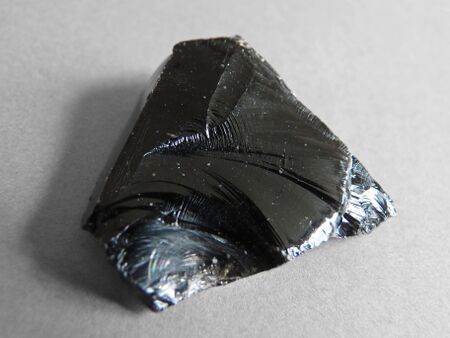Volcanic glass/Obsidian
Obsidian is a very fine-grained extrusive igneous rock. One could not say something about the minerals present, because it cooled so rapidly that the atoms couldn't arrange themselves into crystals and gave this rock an amorphous structure. This results in volcanic glass with a smooth uniform texture that breaks with a conchoidal fracture.
Characteristics
Obsidian forms from the same kind of magma/lava as rhyolite and granite and has therefore the same composition as these rock, however no minerals can be seen. In its glass form obsidian is very unstable and can crystallize further when time passes. This crystallization happens at different spots in the rocks where a radial cluster is formed and grey crystals appear.
There are other rocks that form by rapid cooling. When the magma/lava has the composition out of which basalt and gabbro form than the rapid cooled rock is called tachylyte. Moreover pumice and scoria can form. These rocks form from the same magma/lava as obsidian, but form by eruption and have a lot of gasses present in the lava when cooled. This causes these rocks to be very permeable and lot of vugs can be seen.
Environment
Obsidian can form in a variety of cooling environments which are as follows:
- Along the edges of a lava flow.
- Along the edges of a volcanic dome.
- Around the edges of a sill or dike.
- Where lava contacts water.
- Where lava cools while airborne.
References
Obsidian

| Type | Extrusive igneous rock |
|---|---|
| Structure | Amorphous |
| Clasts | Fine grained |
| Hardness | Very hard |
| Color | grey to black |
| Minerals | Can't be described |
| Touch | Rough or smooth |
| Image | Obsidian image |